POLYETHYLENE GLYCOL (PEG) 3350 - ORAL
PHONETIC PRONUNCIATION: (paw-lee-ETH-ih-leen GLY-coll)
COMMON BRAND NAME(S): Miralax
GENERIC NAME(S): polyethylene glycol 3350
Uses
USES: This medication is used to treat occasional constipation. It works by holding water in the stool to soften the stool and increases the number of bowel movements. It is known as an osmotic-type laxative. This medication is also available without a prescription. If you are taking this medication for self-treatment, it is important to read the manufacturer's package instructions carefully so you know when to consult your doctor or pharmacist. (See also Precautions.)
How to use POLYETHYLENE GLYCOL (PEG) 3350 - ORAL
HOW TO USE: Take by mouth usually once daily, or as directed by your doctor or the directions on the product package. If you are prescribed the individual packets, mix the powder as directed by your doctor or pharmacist. If you are using the bulk bottle, use the provided cap to measure the prescribed dose. Mix the powder with a glass (4-8 ounces/120-240 milliliters) of liquid such as water, juice, soda, coffee, or tea. Before drinking the solution, stir the powder well until it completely dissolves. If you have any questions, ask your pharmacist. It may take 2 to 4 days after you have started this medication to have a bowel movement. Do not increase your dose or take it more frequently than prescribed. Also, do not use this medication for more than 2 weeks unless directed by your doctor. Tell your doctor if your condition persists or worsens. Extended use or overuse may result in dependence on laxatives and chronic constipation. Overuse may cause diarrhea, excess loss of body water (dehydration), and mineral imbalance (e.g., low sodium). If you are using nonprescription polyethylene glycol for self-treatment of occasional constipation and this treatment has not worked after 7 days, talk to your doctor for additional treatment advice.
Side Effects
Precautions
Interactions
Overdose
Images
Reviews
Faq for POLYETHYLENE GLYCOL (PEG) 3350 - ORAL
Polyethylene Glycol (PEG) 3350 is an osmotic laxative used to treat occasional constipation. It helps to soften the stool and make bowel movements easier.
PEG 3350 works by drawing water into the colon, which helps to soften the stool and increase the frequency of bowel movements.
On average, it may take anywhere between 12 to 72 hours for PEG 3350 to produce a bowel movement. However, this can vary from person to person.
Polyethylene Glycol (PEG) 3350 is generally considered safe for short-term use. However, it is important to follow the recommended dosage and duration of use provided by your healthcare provider.
Common side effects of PEG 3350 may include bloating, gas, nausea, stomach cramps, and diarrhea. These side effects are usually mild and temporary.
In general, PEG 3350 does not have significant drug interactions. However, it is always advisable to consult with your healthcare provider or pharmacist before taking any medications together.
Pregnant or breastfeeding women should consult their healthcare provider before using PEG 3350 to ensure its safety for their individual circumstances.
PEG 3350 is typically taken orally once a day, or as directed by your healthcare provider. It is usually mixed with a beverage and should be swallowed immediately.
It is generally safe to consume alcohol in moderation while taking PEG 3350. However, excessive alcohol consumption can worsen certain side effects, such as dehydration.
Disclaimer
IMPORTANT: HOW TO USE THIS INFORMATION: This is a summary and does NOT have all possible information about this product. This information does not assure that this product is safe, effective, or appropriate for you. This information is not individual medical advice and does not substitute for the advice of your health care professional. Always ask your health care professional for complete information about this product and your specific health needs.
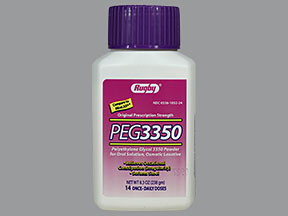
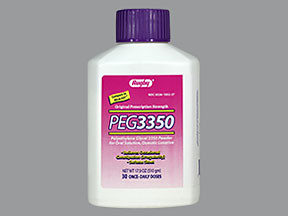
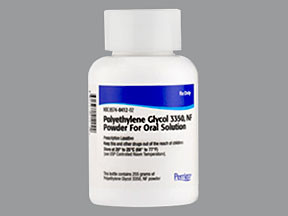
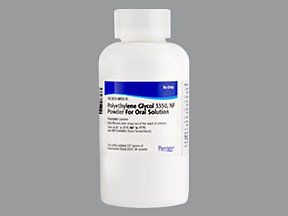
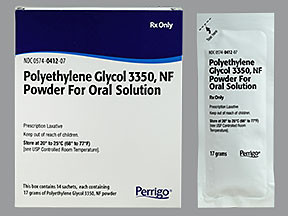
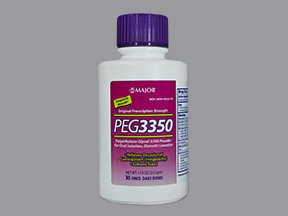
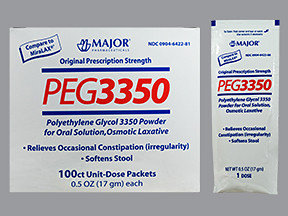
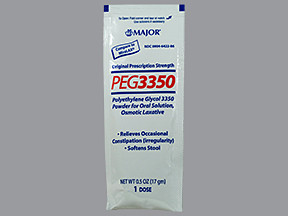
No Reviews Yet